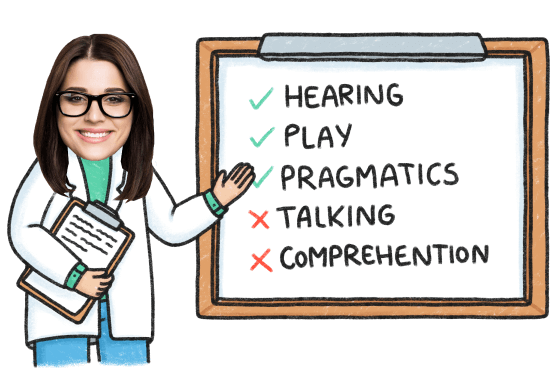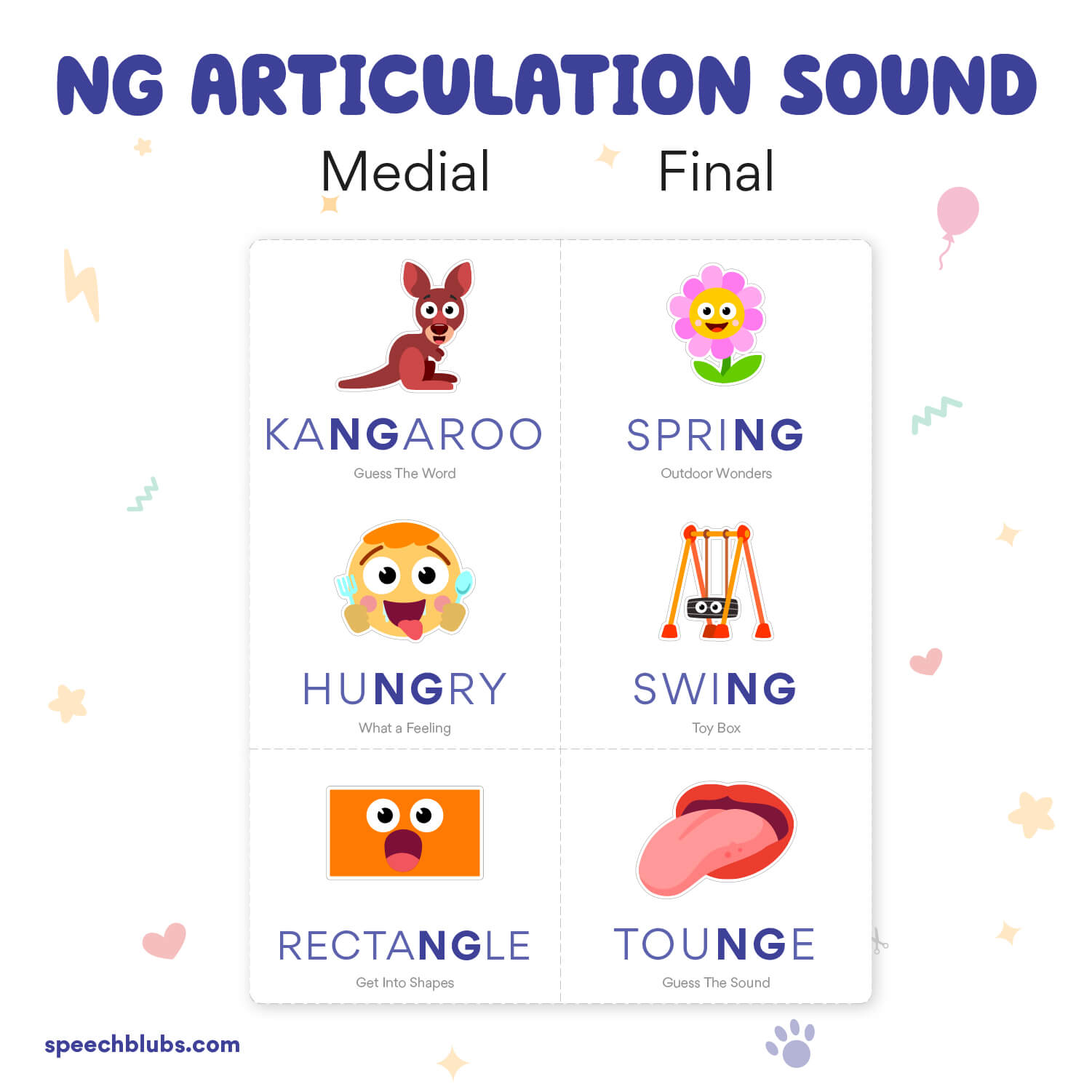NG Sound Articulation Therapy: A Guide for Parents
Jan 25, 2022 The NG sound is a single sound production, although it is made up of two different letters and sounds very similar to “n.” Here you'll find some speech therapy activities that will help your child to perfect the sound.
Most of the time, if your child is having difficulty with ng sound articulation, they are either omitting it completely (deleting the sound) or substituting it with something else.
In addition, if your child has been diagnosed or had surgery to correct a cleft palate, the sound can be of particular difficulty due to where the sound is placed and the amount of nasality that is required. Early intervention is key in helping your child’s speech, so if your child is struggling with the sound, contact your local speech-language pathologist (SLP) to rule out an articulation disorder.
Show Visual and Audio Cues with the Help of Speech Blubs
Speech Blubs App has multiple activities that you can use to target specific speech sounds. The games are fun and highly engaging, so your child won’t even realize that they are working on speech sounds!
Boost Your Child’s Speech Development!
Improve language & communication skills with fun learning!

When Does the Sound Occur?
Kids typically start using the “ng” sound around the age of 2. Even though they begin to utilize it at this age, they don’t totally perfect the sound until around 5-6. If your child is still not making the “ng” sound correctly by their 6th birthday, I would suggest getting them evaluated by a SLP to make sure therapy isn’t necessary.

How is the /NG/ Sound Produced?
According to Chicago Speech Therapy, the /ng/ sound is produced just like the /n/ sound.
The /ng/ sound is a nasal sound, which means that the air passes through the nasal passage instead of through the mouth when making the sound. To make this sound, lift the back of your tongue against the soft palate, which is the soft area at the very back of the roof of your mouth, forming a seal. Then make a sound with your vocal cords. Since you have closed off your mouth, the air travels through your nose, creating the /ng/ sound.
If you’re practicing this right now, which I totally did as I was explaining the process to you, you can see how kids can get confused between the /n/ and the /ng/ sound; the only difference is where your tongue hits the roof of your mouth. The /n/ sound makes your tongue hit the front of your mouth, while the /ng/ sound is towards the back.
How Can you Help at Home?
Working on any speech sound at home can be fun and rewarding for your child. First of all, they aren’t in a therapy room with some speech therapist that they hardly know. Secondly, you can actually get them outside and moving, which will lead to them having more fun and increased carryover.
And you don’t have to spend any money on activities. Most of the things I’m going to suggest, you most likely have at your disposal OR it involves just talking to your child.
Verbal Cues for the /NG/ sound
To begin, make sure you are saying the sound clearly and loudly enough for your child to hear it and imitate it. For example, say /ng/, /ng/, /ng/, three times to your child. Make sure you say it slowly and you have his/her eye contact.
Encourage your child to repeat it back to you. Keep doing this and your child will eventually say the sound successfully without intervention. Once he/she gets the sound in isolation, then move to syllables, such as “ing,” “ang,” and “ung.”
Again, once your child masters this level, they can move to words, phrases, and then sentences. It’s a tiered process that your speech pathologist can walk you through step-by-step.
Tactile Cues for the /NG/ sound
Tactile cues are just another way of saying “touch” cues. Since /ng/ is a nasal sound, the tongue blocks the air through the mouth and it instead flows through the nose.
If your child has trouble with this, have him hold his nose as he makes the sound. When the air gets trapped and cannot exit either the nose or the mouth, he will know that he is making the sound correctly.
If the air can escape through his mouth, he will know that he needs to reposition his tongue. Another cool feature of nasal sounds is that they vibrate your nose as you say them. Encourage your child to touch the side of his nose when making the /ng/ sound to feel the vibrations. Sometimes that’s all it takes for the sound to “click” in the child’s brain.
Activities to Practice the /NG/ Sound at Home
One of my favorite resources to work on any articulation skills is Speech Blubs. All you have to do is download the Speech Blubs app and look at the Mouth Gym activity. It will teach your child to correctly produce the sound and then give him/her fun resources to practice.
Use these sections to practice the /NG/ sound:
- Outdoor Wonders: Spring.
- Animal Kingdom: Kangaroo.
- Living Colors: Orange.
- Toy Box: Swing.
- Get into Shapes: Triangle, Rectangle.
- This is my Body: Tongue.
How to Play Articulation Bingo?
- Use the button below to download our Articulation Bingo Board;
- Print out the board and give it to your child or cut out the pictures and put them into a bag;
- Let your child pick a word from the board/bag;
- Find the word in Speech Blubs App and practice it, play with fun filters and watch educational videos;
- Your child is a winner when he practices three pictures in a row (across, down, or horizontally) or the entire board.
Good Screen Time!
I’ve seen kids get so into the app and they have no idea that they are actually performing speech therapy. Don’t worry – it’s good screen time!
Make sure you sit with your child and are actively engaged with them while they are using the app. Have them show you the silly faces, make sure they are telling you what they are pointing to.
“Sing, Sang, Song”
Another way you can practice this sound is to play a singing game with your child. No matter what song you are singing, replace all of the words with “sing, sang, song.”
Kids love that they can be silly and use the wrong words. It gives them so many different opportunities to practice the sound throughout the course of a three minute song. If they get bored with those three words, then use words like “ring, sting, wing, king, bring.” Be creative!
There are so many online worksheets and games that you can Google online. If your child loves to work on worksheets, you can check out many websites.
They have a ton of different free worksheets that you can play with your child. You can even make it a Bingo-type set-up; every time they say the sound correctly, they can put a chip on the picture. Whoever gets so many in a row, wins.
Reading Together is Important
Finally, read to and with your child. Have them repeat certain words to you, especially if it is a sound that you are targeting. Even five minutes a day will show an increase in academic and reading performance in school!
/NG/ sound articulation issues are not the only ones to consider. If your child has difficulties with other sounds, here are the articles that can help you with speech therapy and articulation activities ideas:
- Articulation Therapy: An All-in-One Guide for Parents
- B Sound Articulation Therapy
- H Sound Articulation Therapy
- JJ and CH Sounds Articulation Therapy
- L Sound Articulation Therapy
- Lisp Articulation Therapy
- M Sound Articulation Therapy
- N Sound Articulation Therapy
- R Sound Articulation Therapy
- S Sound Articulation Therapy
- SH Sound Articulation Therapy
- T and D Sounds Articulation Therapy
- W Sound Articulation Therapy.


